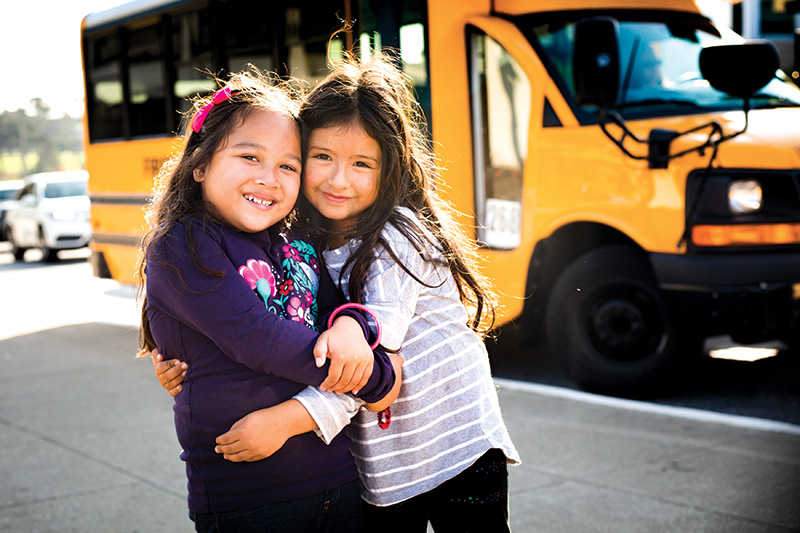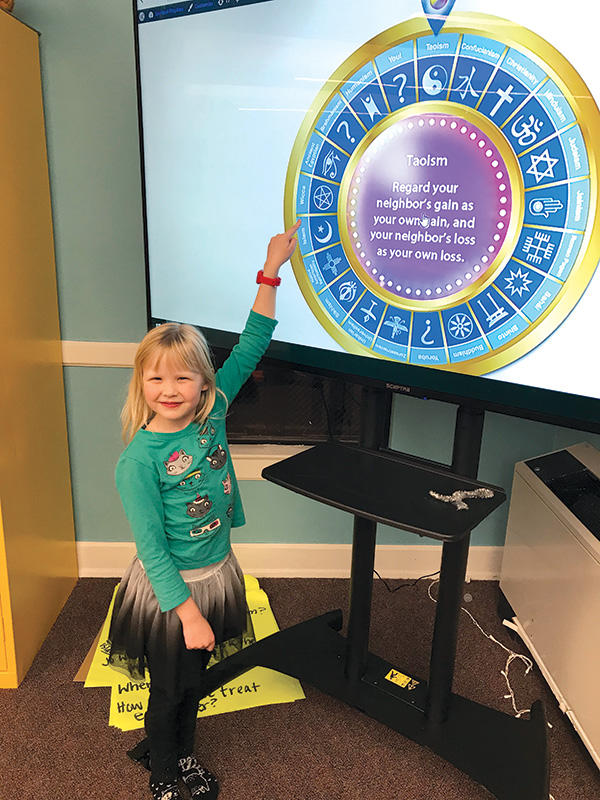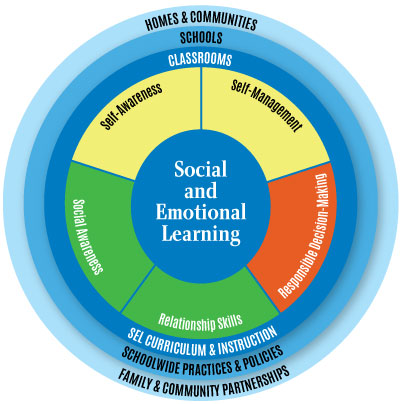How Social-Emotional Learning Transforms Students and Schools
Every educator can play a role in SEL, which has been shown to boost academic achievement and improve educational outcomes.

In the picture book The Princess and the Fog by Lloyd Jones, an otherwise happy princess finds that she is not able to enjoy doing her favorite things when a fog unexpectedly settles around her. At first, she doesn’t know what to do, but she learns that talking about her feelings helps lift the fog. For children who have a loved one living with depression or who experience it themselves, it’s a clear-eyed illustration of an emotional condition that can be difficult to put into words.
Children who take home this book from the Rutland Free Library in rural Vermont will soon have access to a wealth of other supportive resources to go along with it. As part of a social and emotional (SEL) learning unit, English students at nearby Fair Haven Union High School compiled depression toolkits that kids and parents can check out with a public library card to help when a family member is living with depression.
In addition to The Princess and the Fog and books for teens (Depression: A Teen’s Guide to Survive and Thrive; When Nothing Matters Anymore: A Survival Guide for Depressed Teens), the toolkit resources, which come in a cloth bag, include a list of depression warning signs, a list of local counselors, and writing and drawing activities to help elementary-age children cope with depression symptoms. The project, known as the Healing Library, is meant to use library tools to extend the SEL that students undertake in the classroom to the community at large.
“The idea with the Healing Library is how libraries can serve families during times of trauma,” says Deborah Ehler-Hansen, the school librarian, who co-designed the SEL unit with the English department chair. “Our educators believe in providing for the social, emotional, and academic needs of every child.”
Fair Haven Union is among the thousands of schools across the country elevating social and emotional development alongside academic achievement for its students. Over the last 20 years, these schools and districts have adopted SEL programs in light of widespread evidence that they boost academic achievement and improve educational outcomes.
 |
Students from the San Francisco Unified School District,
|
Implementations of SEL range broadly, from specific initiatives like the one at Fair Haven Union to district-wide adoptions to foster mindful, engaged behavior among students. Recognizing the value of emotional awareness for any student population, the core SEL competencies include self- and social awareness, relationship skills, decision-making, and self-management, according to the Collaborative for Academic, Social, and Emotional Learning (CASEL), the preeminent research and policy organization for SEL. While many schools and districts adopt SEL-specific curricula, others incorporate practices such as meditation and yoga that promote calm and focus among very young children.
Decades of research have made a convincing case that every educator has a role to play in promoting SEL. A recent survey by the RAND Corporation showed that 60 percent of teachers and principals set SEL goals. All 50 states set SEL standards for preschool education, and 16 expand them through the early elementary or K–12 grades, according to the National Conference of State Legislatures. A landmark 2011 meta-analysis published in the journal Child Development showed that children exposed to SEL programs in schools have an 11-percentile-point advantage in academic achievement. These initiatives improve behavior, attendance, graduation rates, and college and career success, according to a 2018 Aspen Institute report.
“We believe that if a student feels that the adult in the classroom really cares about them and believes that they will be successful, that student will be able to stay in class and work through conflicts,” says Kevin Truitt, chief of student, family, and community support for the San Francisco Unified School District, which has implemented SEL curricula for all grade levels and gives each school an annual score assessing how conducive the school climate is to social and emotional learning based on surveys of students, parents, and staff. “Students will be able to regulate their own emotions and behavior better if they’re in a caring environment.”
The SEL movement in education took shape in the 1990s and gained traction in 1994, when child researchers and educators came together to form CASEL.
A year later, SEL entered widespread mainstream awareness with the publication of New York Times reporter Daniel Goleman’s best-selling book Emotional Intelligence: Why It Can Matter More Than IQ. The premise of the book, based on Goleman’s science reporting, was that “soft” skills, such as empathy and self-discipline, are materially tied to success in life, and that an individual’s feelings and relationships are linked to skills that they can refine and hone. Over the following two decades, continuing research by CASEL and others solidified the field of SEL. Now, CASEL partners with 21 school districts in major cities across the country to help them incorporate SEL into their educational programs. CASEL provides research, resources, and guides to help districts implement SEL at a district-wide level—crucial to creating organizational change and a nurturing educational climate for all students, CASEL maintains.
 |
At Oak Park (IL) Public Library, an SEL session on world religions included a wheel describing faiths and core values.Photo courtesy of the Oak Park Public Library |
The core competencies
SEL approaches have touched hundreds of thousands of students and have been adapted to meet the needs of local communities. But at their heart, SEL programs are characterized by their commitment to developing the five core competencies. One way that these skills are taught is through direct classroom instruction. Second Step, for instance, is a K–8 SEL curriculum that is used by school districts throughout the country as a resource for lessons in empathy, impulse control, and communication skills. For younger students, the curriculum uses dolls, songs, and games to give kids tools for calming down and negotiating fair play with friends. For middle schoolers, digital tools address topics like goal-setting, bullying, and gratitude.
An effective SEL program goes well beyond lesson plans, however, and libraries can play a key role. SEL practices should be integrated into the educational culture by making schools and libraries warm, supportive spaces that foster positive relationships and integrate restorative methods to deal with conflict and discipline issues, says Hank Resnik, CASEL’s senior adviser for communications. That means bringing everyone on board, from the school principal to the librarians to the school bus drivers.
“The bus driver is part of the whole experience of the school,” Resnik says. “One thing they can do is know the kids by name and greet them with a smile and welcome them on the bus.”
When students feel positive about their schools and the people in them, they will perform better and have a greater capacity to meet challenges.
“Emotional regulation is a by-product of your surroundings,” says Truitt: A student who doesn’t feel safe and supported in school is more likely to lash out or fight when they face a conflict. “They’re kids; their brains aren’t developed. Sometimes they’re so confused they don’t know what they’re reacting to.”
The five core competencies are central, because these skills in self-control and conflict resolution will help children navigate challenges in school, in their families, and in the workplace throughout their lives. Many schools have adopted meditation and yoga programs in recent years. These practices can be understood as useful tools that can help children develop the core competencies, according to Resnik. “Mindfulness and yoga are good ways of helping young people develop self-control and calm down,” Resnik says. “Kids are cognitively able to control themselves.”
A shift in school culture
Every student, district, and student population have different challenges and needs. Atlanta Public Schools, a CASEL partner district, adopted a district-wide SEL initiative four years ago as part of a culture change brought in by the new superintendent, Meria Carstarphen. She took over Atlanta’s schools in the wake of a cheating scandal that resulted in the criminal conviction of dozens of the city’s educators.
Now all schools in the district teach an SEL curriculum—Second Step for grades K–8 and School-Connect for high schooler students. The district also provides teacher training and wellness resources for teachers and students, and a comprehensive support system to make sure students have everything from clean clothes to psychological services as part of a “whole child education” focus, according to Lindsay Wyczalkowski, a coordinator of SEL for the school district.
Wyczalkowski developed an SEL book of the month club for elementary schools that is used by teachers, librarians, and school principals to engage students around SEL themes. Each month’s book is selected to match with an SEL competency and a theme within that competency; for instance, Let the Children March by Shane W. Evans, about the 1963 civil rights march on Washington, D.C., is linked to the competency of responsible decision-making and the theme of problem-solving. Wyczalkowski provides the schools with guided reading questions, suggested activities, and lesson ideas to accompany each book. The school librarians create a section of the library where the book of the month and other SEL books are highlighted.
“We’ve been using literature for thousands of years to really talk about values and belief and culture,” Wyczalkowski says. “We’re going to support kids’ academic needs and lift them up, but we’re also going to make sure we’re supporting their social and emotional needs.”
In Oak Park, IL, outside of Chicago, the public library created a popular series of bimonthly family workshops aimed at building empathy and addressing topics such as compassion, gender identity, and differences in religious belief. The program was inspired by parents who asked the librarians to help them prepare children for a service project with local refugee families. In the workshops, the families typically share a meal, read a book, and do a craft together related to the theme. In a workshop about refugees, the librarians drew a large suitcase and had parents and children fill it with Post-it notes listing the things they would bring with them if they had to leave their homes. Then they told them they could only bring 10 items with them, then five, then nothing at all.
“A five-year-old said, ‘Having my family would be the most important.’ She said, ‘I would want my sister, my mom and my dad,’” says Jennifer Jackson, the library’s specialist for children’s programming and outreach. The activity helped children build the core competency of social awareness, which includes empathy for those different from you. “[It] was just a small way for the children to identify with what this journey is. It has to be a really big reason to make you leave everything that’s familiar to you.”
In Vermont, the students at Fair Haven Union are coming out of a difficult year in which a fellow student was arrested for planning a school shooting. The student, who had spoken positively about the school shooting in Parkland, FL, was found to possess guns, ammunition, and a journal detailing his plan. In the wake of the arrest, attendance at school dropped, and students experienced stress and panic attacks.
 |
CASEL’s SEL competenciesSource: CASEL |
Librarian Ehler-Hansen was looking for a way to help meet the community’s emotional needs when she adapted the Healing Library program, originally from children’s literature website Curious City DPW, to use with Fair Haven Union’s 12th grade English program.
The seniors were reading The Curious Incident of the Dog in the Night-Time, told from the first-person perspective of a narrator on the autism spectrum. The unique point of view forces readers to put themselves in another person’s shoes, an important step in developing empathy. As the students were creating toolkits addressing issues in the book such as autism, depression, anxiety, and divorce, school counselor Julie Marsden facilitated conversations and led the class through exercises they could use to help themselves, a friend, or a family member who was struggling.
“I try to help normalize mental health issues,” Marsden says. “I want to take the stigma away from it, to acknowledge that it’s out there. Many people struggle with these issues, and they’re not alone in this.”
At its heart, the SEL approach to education means understanding schools as a place to build relationships. When students act out, Wyczalkowski says, they are often expressing an unmet need, whether emotional or material. She once heard a story about a child who was throwing things in class and couldn’t calm down. Finally the teacher asked what was wrong, and the student said, “I’m hungry.” The teacher gave him a granola bar.
“If we don’t stop to ask what’s wrong, we don’t get the answer that we need,” Wyczalkowski says.
Drew Himmelstein is a writer and digital editor in Brooklyn, NY. She last wrote about teaching consent for SLJ.
RELATED
The job outlook in 2030: Librarians will be in demand
The job outlook in 2030: Librarians will be in demand
ALREADY A SUBSCRIBER? LOG IN
We are currently offering this content for free. Sign up now to activate your personal profile, where you can save articles for future viewing





Add Comment :-
Be the first reader to comment.
Comment Policy:
Comment should not be empty !!!